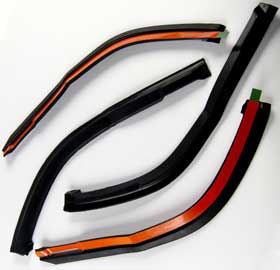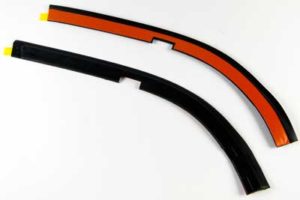Molded Parts
 Compression molding is a forming process in which a plastic (rubber or thermoplastic) material is placed directly into a heated metal mold, then is softened by the heat, and forced to conform to the shape of the mold as the mold closes.
Compression molding is a forming process in which a plastic (rubber or thermoplastic) material is placed directly into a heated metal mold, then is softened by the heat, and forced to conform to the shape of the mold as the mold closes.
The molding material is measured to an exact size and weight (“preforms”), generally preheated and positioned in the mold cavity; this all but eliminates excess flash. The mold is closed; pressure is applied to force the material into the mold cavity or cavities; and heat and pressure are maintained until the molding material has cured. Inserts, usually metallic, can also be molded in-place using this process.
 High-volume, high-pressure method suitable for molding complex shapes
High-volume, high-pressure method suitable for molding complex shapes
The advantage of compression molding is its ability to mold large, fairly intricate parts.
Low cost molding method
Also, it is one of the lowest cost molding methods compared with other methods such as transfer molding and injection molding; moreover it wastes relatively little material, giving it an advantage when working with expensive compounds. Some part geometries do not lend themselves to the process; design and application engineers must confirm “part/process” compatibility.
Compression molded thermoplastic materials are commonplace in mass production industries. One significant example is automotive applications where the leading technologies are long fiber reinforced thermoplastics (LFT) and glass fiber mat reinforced thermoplastics (GMT).
Markets
Automotive Tier 1
Heavy Truck OEM
Construction Equipment
Off-Road Vehicles
Industrial
Materials
EPDM
Nitrile
Neoprene
Silicone
TPE/TPV
Processes
Notching/Drilling
Coating
Compression Molding



